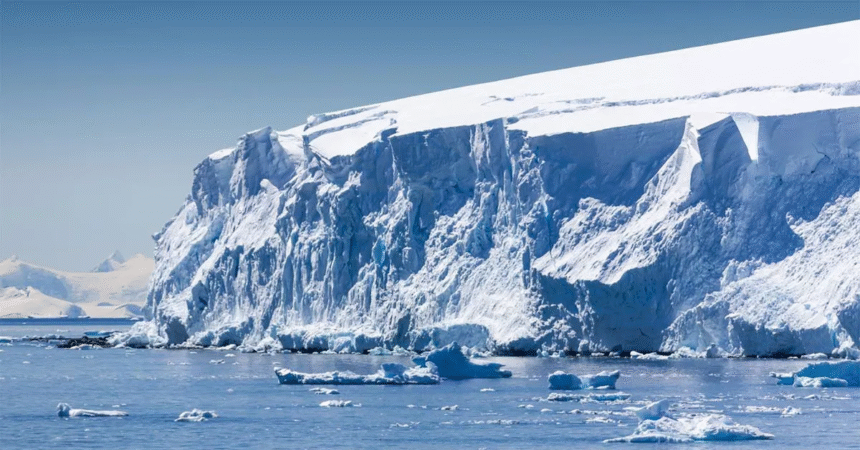The phrase “doomsday glacier” might sound like something straight out of a science fiction movie, but it’s actually a term used to describe glaciers such as the Thwaites Glacier in Antarctica. This massive ice sheet has scientists and environmentalists deeply concerned, primarily due to its potential impact on global sea levels. The Thwaites Glacier, along with other Antarctic glaciers, holds the key to understanding how climate change is reshaping our world.
What is the Thwaites Glacier?
The Thwaites Glacier is one of the largest and most vulnerable ice sheets in Antarctica. Covering an area roughly the size of Florida, it holds a staggering amount of frozen water—enough to raise sea levels by over 10 feet if it were to fully melt. Although this might sound alarming, the glacier’s collapse is not an immediate event, but it is a pressing concern for the future.
How Does the Thwaites Glacier Impact Global Sea Levels?
The potential collapse of the Thwaites Glacier is a ticking time bomb for our planet. Sea levels are rising at an accelerating rate due to the melting of polar ice, with the Thwaites Glacier being a major contributor. The glacier is already retreating, and as more ice melts and enters the ocean, it will directly affect coastal communities and ecosystems across the world. Scientists have warned that if the Thwaites Glacier were to collapse entirely, it could cause sea levels to rise by over 10 feet, which would submerge low-lying coastal areas, displacing millions of people globally.
The Role of Climate Change in Melting Ice
One of the primary reasons for the accelerated melting of the Thwaites Glacier and other Antarctic ice sheets is climate change. Rising global temperatures, driven by human activities such as the burning of fossil fuels, have caused significant warming in the polar regions. This warming has led to the melting of glaciers at an alarming rate. In particular, the Thwaites Glacier is being eroded from below by warmer ocean water, which causes the ice to melt faster than it would from the surface alone.
Basal Melt: The Process Behind Thwaites Glacier’s Retreat
The term “basal melt” refers to the process by which the underside of a glacier melts due to warmer ocean water flowing beneath it. In the case of the Thwaites Glacier, this process is taking place at an accelerated rate. The warm ocean water weakens the ice sheet, causing it to disintegrate. As more ice is lost, the glacier becomes less stable, contributing to a feedback loop of further melting.
The Environmental Impact of Glacier Melting
The effects of the Thwaites Glacier’s potential collapse extend beyond just rising sea levels. The environmental impact of melting ice in Antarctica is multifaceted. For one, the influx of freshwater into the ocean disrupts ocean currents and could change weather patterns globally. This disruption in ocean circulation can lead to more extreme weather events, including stronger storms, heatwaves, and flooding.
Additionally, the loss of glaciers in the polar regions has consequences for the ecosystems that depend on them. Species adapted to cold environments, such as penguins and seals, could be at risk as their habitat shrinks. Furthermore, melting glaciers contribute to changes in the Earth’s albedo effect—where the Earth reflects sunlight back into space. The loss of ice sheets reduces the amount of sunlight reflected, causing more heat to be absorbed by the ocean and accelerating global warming.
The Relationship Between Global Warming and the Doomsday Glacier
Global warming is not just a distant concern for future generations; it is a present-day reality that affects us all. The melting of glaciers like Thwaites is a direct result of the rising global temperatures driven by human-caused greenhouse gas emissions. As the Earth’s atmosphere warms, more ice melts, which in turn accelerates sea-level rise. This is a vicious cycle that threatens coastal cities, agricultural lands, and ecosystems.
One of the most concerning aspects of the Thwaites Glacier’s retreat is the potential for an irreversible collapse. If the glacier reaches a critical tipping point, it could trigger a chain reaction that would make it impossible to slow down the melting process. This scenario is a serious concern for climate scientists and highlights the urgent need for global action on climate change.
Scientific Research on Thwaites Glacier
To better understand the Thwaites Glacier and its impact on global sea levels, scientists are actively conducting research in Antarctica. International collaborations are key to studying the glacier’s behavior and monitoring its rate of retreat. This research involves a combination of satellite observations, ice core drilling, and oceanographic studies to measure the temperature of the water beneath the ice and how it affects the glacier’s stability.
Through this scientific research, experts hope to better predict the future of the Thwaites Glacier and other ice sheets around the world. Accurate climate models are essential to understanding the potential scenarios of ice sheet collapse and the impact they may have on global sea levels. The more we learn about these glaciers, the better we can prepare for the changes that lie ahead.
The Future of the Polar Regions
As climate change continues to accelerate, the polar regions, especially Antarctica, will undergo significant changes. The Thwaites Glacier is just one example of how global warming is reshaping the ice sheets that have stood for millions of years. These changes will have profound consequences for our planet, from rising sea levels to extreme weather patterns and shifts in ecosystems.
The Thwaites Glacier is not the only glacier facing threats due to global warming. Other glaciers in Antarctica, as well as those in Greenland, are also experiencing accelerated melting. These changes are a wake-up call for the need for stronger environmental policies and global cooperation to combat the climate crisis.
What Can Be Done to Address the Climate Crisis?
Addressing the climate crisis requires urgent action on multiple fronts. Reducing greenhouse gas emissions is the primary way to slow the melting of glaciers and limit global temperature rise. By transitioning to renewable energy sources, promoting sustainability, and reducing our carbon footprint, we can reduce the long-term effects of global warming.
Governments, scientists, and environmental organizations must work together to implement policies that protect our planet’s ecosystems, especially in the polar regions. In addition, investments in geoengineering and climate adaptation strategies will be crucial for managing the effects of climate change and preparing for the future.









